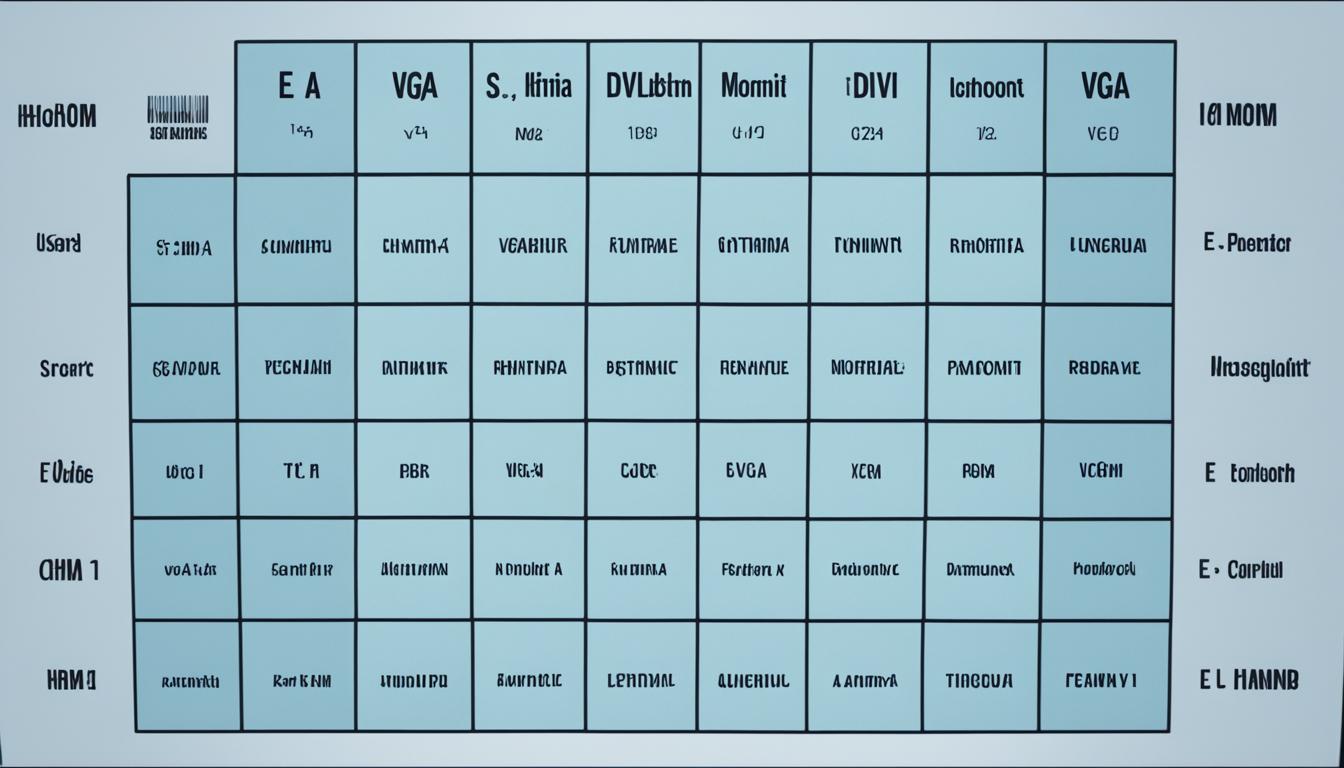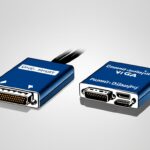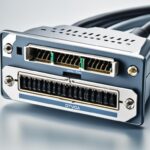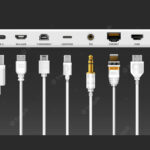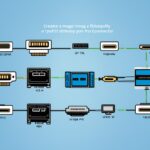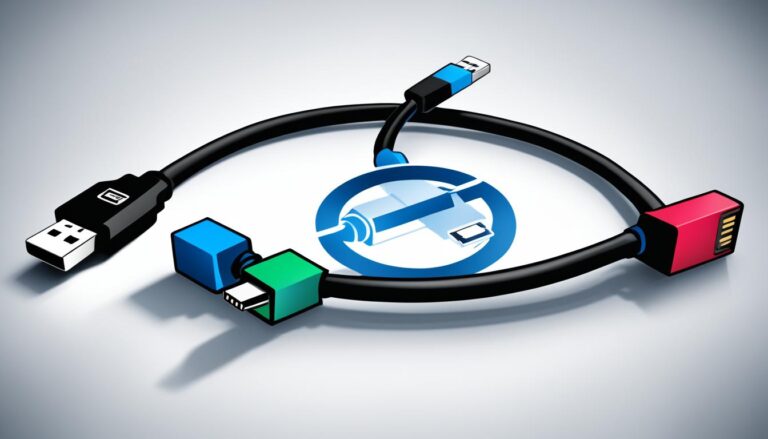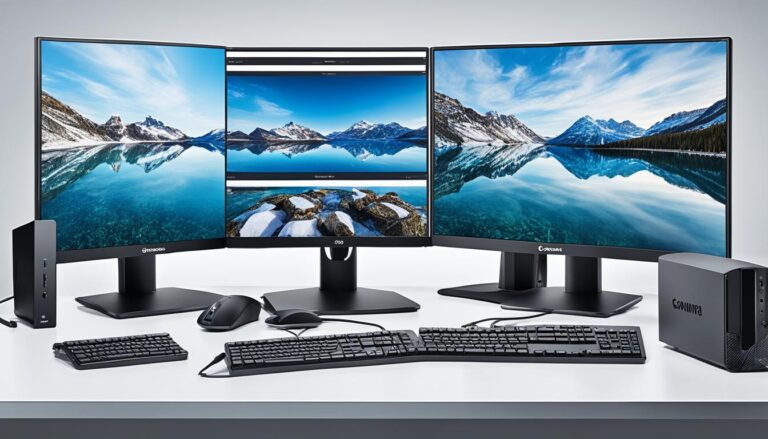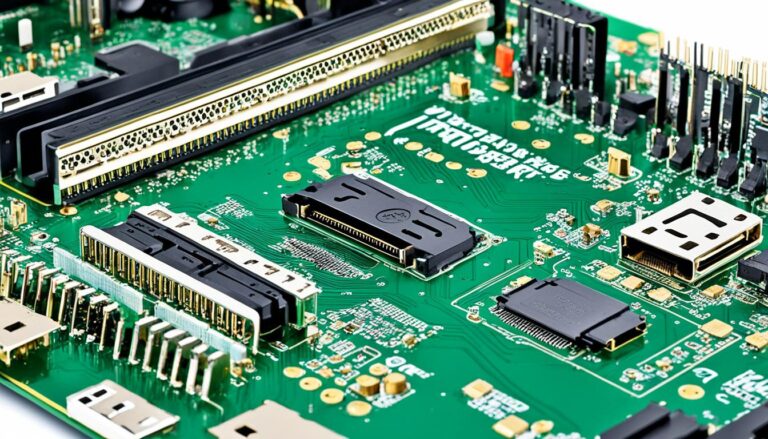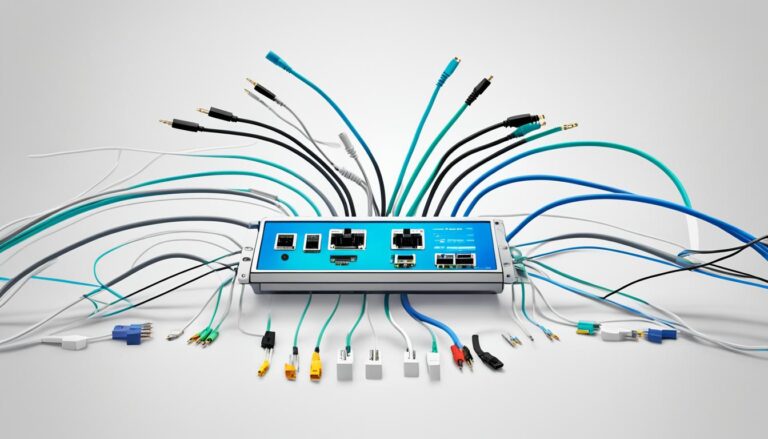Welcome to our guide on monitor ports and their uses. We will explore the ports that connect devices to displays. Knowing about these ports and what they do is key for a great display setup.
If you love multimedia, play games, edit professionally, or just want your laptop on a big screen, knowing about ports is important. We will look at HDMI, DVI, DisplayPort, VGA, USB-C ports, and more.
Let’s learn about each monitor port type, plus their good and bad points. By the end of this, you’ll know which port does what. This will help you choose the right one for your needs.
HDMI Port
The HDMI port is a key feature in today’s monitors. It is the main way to connect devices for multimedia. HDMI stands for High Definition Multimedia Interface. It handles audio and video signals, offering a great multimedia experience.
With HDMI, high-quality sound and visuals come through one cable. This cable carries all multimedia signals, making setup simpler. It cuts down on cable clutter. The port plays different audio types, including surround sound. This ensures an amazing sound to go with great visuals.
HDMI keeps getting better with every new version. These updates improve your viewing. The newest versions support very high resolutions. They are perfect for watching films, gaming, or editing videos. With an HDMI port, the content looks fantastic.
An HDMI port works with many devices. Connect your monitor to a console, Blu-ray player, streaming device, or laptop. HDMI ensures a smooth connection and top performance. Its ability to work with various devices makes it a favourite for home and professional use.
Moreover, HDMI can meet modern display needs. It supports very high resolutions, like 4K and 8K. This lets you see incredible image quality. Details are sharp and colours are bright. HDMI also has 3D features for compatible displays.
In short, the HDMI port is crucial in modern monitors. It offers a handy and flexible way to connect multimedia devices. HDMI transmits audio and video, handles high resolutions, and advanced sound. Its benefits, like being compatible with many devices and supporting high resolutions and 3D, make it the top choice for multimedia connections.
DVI Port
The DVI port is often found on older systems and screens. It stands for Digital Visual Interface. It can send both analog and digital signals, making it very useful.
Different DVI cables exist, like DVI-I, DVI-D, and DVI-A. They each serve distinct purposes. Users can pick the type that fits their screen’s needs best.
For those who need smooth visuals, the DVI port is great. It offers better frame rates and image quality than VGA. Gamers and digital artists will find it especially helpful.
But, the DVI port cannot handle 4K video. If you want the very best resolution, you might need HDMI or DisplayPort instead.
Advantages of DVI Port:
- Supports both analog and digital signals
- Provides higher frame rates
- Offers better image quality compared to VGA
The DVI port is still a good option for those with older tech. It may not support the top resolutions, but it has benefits for certain needs. It ensures a stable display link for both analog and digital screens.
DisplayPort
The DisplayPort is a newer and more versatile port option that offers several advantages. It’s often chosen for high-end gaming and video editing because of its support for high resolutions. It also lets users connect more than one monitor easily.
DisplayPort supports high resolutions, including 4K and 8K. This provides gamers and creative professionals with sharp and detailed visuals. It’s perfect for immersive gaming and accurate video editing.
The versatility of DisplayPort is one of its key strengths. It allows users to connect several monitors to a single DisplayPort output. This multi-display setup increases work productivity and efficiency. It’s great for professionals using complex apps or working on many tasks at once.
Compared to HDMI, DisplayPort provides higher bandwidth and better performance for some tasks. It sends data faster, making gaming smooth and without lag. DisplayPort also supports Adaptive Sync and G-Sync for less screen tearing and smoother gameplay.
DisplayPort Versions:
DisplayPort has evolved over time, with each new version adding features and improvements. The different versions include:
- DisplayPort 1.2: This version brought in Multi-Stream Transport (MST), which lets users link several DisplayPort monitors together.
- DisplayPort 1.3: It upped support for higher refresh rates and higher resolutions like 4K at 120Hz and 8K at 60Hz.
- DisplayPort 1.4: This version improved HDR (High Dynamic Range) support for more vivid and lifelike visuals.
- DisplayPort 2.0: The most current version, DisplayPort 2.0, increases bandwidth markedly, supporting up to 8K at 60Hz or 4K at 240Hz. It also includes Display Stream Compression (DSC) for higher resolution capabilities.
In conclusion, the DisplayPort is a robust and versatile choice for anyone needing high resolutions and multi-monitor setups. Its superior bandwidth and advanced features make it well-suited for demanding applications. DisplayPort is continuously improving and redefining display connectivity.
VGA Port
In this section, we’re going to look at the VGA port, also called Video Graphics Array. This port was found mostly on old devices. Before things like HDMI came along, VGA was the go-to for linking up monitors and devices.
VGA is really for older tech now and doesn’t handle high resolutions like HDMI or DisplayPort can. Although VGA can still show good quality images and videos, it’s stuck at lower resolutions than what new tech can do.
Even though VGA is from the past, some devices still have it. But as the world moves to newer, better ports, VGA is fading away. That’s because the newer options give us clearer pictures and better overall performance.
To sum it up, the VGA port was big back in the day. Nowadays, it’s mostly on old gear and being switched out for better tech. VGA works, but it can’t match the high resolutions of newer technologies.
USB-C Port
The USB-C port is a flexible and widely used connection option. It offers many benefits for users. It is now commonly seen in new monitors and devices because it connects various peripherals well.
One great thing about USB-C is its reversible design. This means no more trying to plug it in the wrong way. With a USB-C cable, connecting your devices becomes a breeze.
The USB-C port is also very versatile. It supports video, audio, data, and power all in one. Whether it’s linking your monitor to a laptop or a smartphone, the USB-C port does it all.
Manufacturers love the USB-C port because it works with many devices. You’ll find it on laptops, smartphones, tablets, and more. This makes connecting different gadgets easy and convenient.
One Cable Type for Multiple Connections
The USB-C port can use just one cable for many types of connections. This means you can connect your monitor to your laptop or smartphone with the same USB-C cable. It makes managing cables easier and cuts down on clutter.
Whether you’re showing your laptop screen on a bigger display, charging your smartphone, or connecting keyboards and mice, just one USB-C cable gets the job done. USB-C offers a simple way to connect your tech.
As our digital world grows, the USB-C port remains a solid choice. It’s versatile, easy to use, and works with many devices. With its support for many types of transmissions and as a single cable for various connections, it’s perfect for both personal and work use.
Other Types of Monitor Ports
In addition to HDMI, DVI, DisplayPort, and VGA, there are less common ports. These include Thunderbolt, AV (RCA), NDI, and SDI. Each has its own special uses and benefits.
Thunderbolt
Developed by Intel and Apple, the Thunderbolt port is very versatile. It’s used for connecting external devices and also for monitors. Thunderbolt supports data, video, and power all in one cable. It’s perfect for pros in multimedia work.
AV (RCA) Ports
AV, or RCA ports, handle analog audio and video with different coloured connectors. Though not often in new monitors, they connect to older tech like VCRs and DVD players.
NDI (Network Device Interface)
NDI sends audio and video over Ethernet. It’s becoming a go-to in broadcasting for its real-time, low-latency video. With NDI, linking devices across a network is straightforward.
SDI (Serial Digital Interface)
SDI is used in professional settings for high-quality, reliable video over long distances. You’ll find SDI mostly in specialist monitors and video gear. It’s known for its superior stability and image quality.
Each monitor port type comes with its advantages and drawbacks. For instance, Thunderbolt suits those needing fast data and multiple displays. AV is great for old audio-video gear. For broadcasting and production, NDI and SDI are key for quality video.
To conclude, knowing about different monitor ports like Thunderbolt, AV, NDI, and SDI helps. It ensures you pick the best port for your needs and get the best connectivity.
| Monitor Port | Advantages | Disadvantages |
|---|---|---|
| Thunderbolt | High-speed data transfer, single cable for video and power, supports multiple monitors | Not as widely supported, higher cost |
| AV (RCA) Ports | Compatible with legacy devices, easy to connect | Analog signal quality, lower resolution support |
| NDI (Network Device Interface) | Real-time video transmission, low latency, easy network integration | Dependent on network infrastructure and compatibility |
| SDI (Serial Digital Interface) | High-quality video signal, long-distance transmission, professional-grade | Not commonly found on consumer devices, higher cost |
Conclusion
Understanding different monitor ports and their uses is key for the best display connection. You might need to connect a monitor to a laptop, game console, or video editing setup. It’s vital to choose the right port type for your needs and device compatibility.
Each monitor port has its own pros and cons. HDMI ports are great for multimedia, with high resolutions and advanced sound. DVI ports, often in older systems, offer high frame rates and sharp images. DisplayPort is best for high-quality gaming and video editing, as it supports high resolutions and can connect several monitors.
VGA ports are less common but useful for older devices. USB-C ports are handy, providing video, audio, data, and power in one. For professional uses, thunderbolt, AV, NDI, and SDI ports are ideal. They meet specific needs in professional settings.
If you need to link devices with different ports, there are accessories and adapters to help. Knowing about these ports and their uses helps you make smart choices for your display needs.
FAQ
What are the different types of monitor ports available?
Monitor ports include HDMI, DVI, DisplayPort, VGA, and USB-C. Each has its own use.
What is an HDMI port used for?
HDMI ports transmit audio and video. They are great for high-definition content.
What is a DVI port?
DVI stands for Digital Visual Interface. It sends analog and digital signals. You’ll find it in older systems.
What is the advantage of DisplayPort over HDMI?
DisplayPort beats HDMI in bandwidth and performance. It’s perfect for gaming and video editing.
What is the VGA port used for?
VGA, or Video Graphics Array, connects older devices. Unlike HDMI or DisplayPort, it doesn’t support high resolutions.
What is the USB-C port used for?
USB-C is versatile, found in newer devices. It transmits video, audio, data, and power.
Are there any other types of monitor ports?
Yes, other ports include Thunderbolt, AV (RCA), NDI, and SDI. Each has unique uses.
Which monitor port should I choose?
Your choice should match your needs and device. Each port has benefits worth considering.
